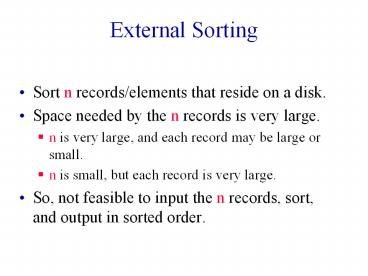External Sorting - PowerPoint PPT Presentation
Title: External Sorting
1
External Sorting
- Sort n records/elements that reside on a disk.
- Space needed by the n records is very large.
- n is very large, and each record may be large or
small. - n is small, but each record is very large.
- So, not feasible to input the n records, sort,
and output in sorted order.
2
Small n But Large File
- Input the record keys.
- Sort the n keys to determine the sorted order for
the n records. - Permute the records into the desired order
(possibly several fields at a time). - We focus on the case large n, large file.
3
New Data Structures/Concepts
- Tournament trees.
- Huffman trees.
- Double-ended priority queues.
- Buffering.
- Ideas also may be used to speed algorithms for
small instances by using cache more efficiently.
4
External Sort Computer Model
5
Disk Characteristics
- Seek time
- Approx. 100,000 arithmetics
- Latency time
- Approx. 25,000 arithmetics
- Transfer time
- Data access by block
6
Traditional Internal Memory Model
7
Matrix Multiplication
- for (int i 0 i lt n i)
- for (int j 0 j lt n j)
- for (int k 0 k lt n k)
- cij aik bkj
- ijk, ikj, jik, jki, kij, kji orders of loops
yield same result. - All perform same number of operations.
- But run time may differ significantly!
8
More Accurate Memory Model
9
2D Array Representation In Java, C, and C
- int x34
Array of Arrays Representation
10
ijk Order
for (int i 0 i lt n i) for (int j 0 j
lt n j) for (int k 0 k lt n k)
cij aik bkj
11
ijk Analysis
- Block size width of cache line w.
- Assume one-level cache.
- C gt n2/w cache misses.
- A gt n3/w cache misses, when n is large.
- B gt n3 cache misses, when n is large.
- Total cache misses n3/w(1/n 1 w).
12
ikj Order
for (int i 0 i lt n i) for (int k 0 k
lt n k) for (int j 0 j lt n j)
cij aik bkj
13
ikj Analysis
- C gt n3/w cache misses, when n is large.
- A gt n2/w cache misses.
- B gt n3/w cache misses, when n is large.
- Total cache misses n3/w(2 1/n).
14
ijk Vs. ikj Comparison
- ijk cache misses n3/w(1/n 1 w).
- ikj cache misses n3/w(2 1/n).
- ijk/ikj (1 w)/2, when n is large.
- w 4 (32-byte cache line, double precision data)
- ratio 2.5.
- w 8 (64-byte cache line, double precision data)
- ratio 4.5.
- w 16 (64-byte cache line, integer data)
- ratio 8.5.
15
Prefetch
- Prefetch can hide memory latency
- Successful prefetch requires ability to predict a
memory access much in advance - Prefetch cannot reduce energy as prefetch does
not reduce number of memory accesses
16
Faster Internal Sorting
- May apply external sorting ideas to internal
sorting. - Internal tiled merge sort gives 2x (or more)
speedup over traditional merge sort.
17
External Sort Methods
- Base the external sort method on a fast internal
sort method. - Average run time
- Quick sort
- Worst-case run time
- Merge sort
18
Internal Quick Sort
- To sort a large instance, select a pivot element
from out of the n elements. - Partition the n elements into 3 groups left,
middle and right. - The middle group contains only the pivot element.
- All elements in the left group are lt pivot.
- All elements in the right group are gt pivot.
- Sort left and right groups recursively.
- Answer is sorted left group, followed by middle
group followed by sorted right group.
19
Internal Quick Sort
Use 6 as the pivot.
Sort left and right groups recursively.
20
Quick Sort External Adaptation
Middle group
- 3 input/output buffers
- input, small, large
- rest is used for middle group
21
Quick Sort External Adaptation
- fill middle group from disk
- if next record lt middlemin send to small
- else if next record gt middlemax send to large
- else remove middlemin or middlemax from middle
and add new record to middle group
22
Quick Sort External Adaptation
- Fill input buffer when it gets empty.
- Write small/large buffer when full.
- Write middle group in sorted order when done.
- Double-ended priority queue.
- Use additional buffers to reduce I/O wait time.































